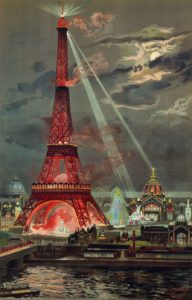As one of the top tourist destinations across the world, the Eiffel Tower has been the symbol of France and Paris since its construction in 1889. It showcases the capital city’s finest structure aside from the stunning buildings, exquisite cathedrals, and Art Nouveau entrances. Though the structure is now Paris’ most recognizable insignia, not all are aware of its contentious birth and distinct history. Truth to be told, the massive structure was not meant to last in the Parisian landscape and was hurdled with skepticism before turning out to be the city’s favorite landmark. Here, discover the beginning and evolution of the Eiffel Tower, the architectural wonder that now stood for over 130 years.
Why was the Eiffel Tower Built?
1889 marked the centennial anniversary of the French Revolution. The French government organized an international exposition (Exposition Universelle) in celebration of the centenary. Plans were already pouring years prior to the event and one of which was to erect a monument in Champ-de-Mars Park in central Paris, that would serve as the entrance for the fair.
With that, a competition was held to gather designs for the monument. Over 100 proposals were submitted but the committee granted the project to Eiffel et Compagnie, a construction and consulting firm owned by the renowned architect, engineer, and bridge-builder Alexandre-Gustave Eiffel.
Though Eiffel himself is often attributed for the tower, Maurice Koechlin and Emile Nouguier, two structural engineers who work for his firm, actually designed and conceptualized the framework of the 300-meter (984-foot) monument. Things didn’t go pretty smoothly. The proposed tower has drawn criticism and skepticism from many prominent figures, questioning the feasibility and the use of erecting such as a monstrous tower. Nevertheless, Eiffel was able to debunk all the protests. Construction went underway on January 28. 1887 and the tower completed on March 15, 1889.
Eiffel Tower’s Prominence
In its inauguration on March 31st, 1889, the Eiffel Tower became the tallest structure in the world at almost 1,000 feet high. It was only in 1930 when it was toppled after the completion of New York’s Chrysler Building that stood 1,046 feet. Nevertheless, the monument was an architectural masterpiece with nothing in its close proximity has ever been erected, doubling the height of the Great Pyramid of Giza, or the dome of St. Peter’s Basilica.
Adding to that, the construction of the Eiffel Tower was relatively cheaper than older structures, plus it required smaller manpower and a shorter completion period of only about two years. Thanks to the advanced knowledge of Eiffel about metal truss and arch forms, the tower became airy yet sturdy, signaling a new era for architectural and civil engineering designs during its era.
Eiffel Tower’s Escape from Destruction
Built as a temporary structure, the Eiffel Tower’s sole purpose was for the 1889 Exposition Universelle. After the event, the tower was meant to remain for another twenty years and then be torn down and scrapped.
In 1909, it was almost destroyed but city officials saved the tower, acknowledging its importance to the city. In 1897, the first radio broadcasts began and the tower acquired a new purpose. During World War I, the monument interrupted enemy radio communications, obtained significant telegrams, exposed spies, and relayed alerts and important troop information. Eiffel Tower escaped demolition the second time around in World War II. Adolf Hitler is said to have ordered the city’s insignia but the actual command was never made.
The Eiffel Tower then has become the site for many important events, stunts, and experiments. It also underwent facelifts, improvements, and modifications for aesthetics, appeal, and preservations.
Final Words
Today, the “Iron Lady” serves as a renowned tourist spot in Paris, enticing millions of visitors each year from across the world and providing them a stunning panoramic view of the city.
Yet, behind its charm, lies a fascinating history from being initially built for an exhibit, to becoming an influence of new architectural style, to eluding its demise, before acting as the cherished figure of the city and the country.


